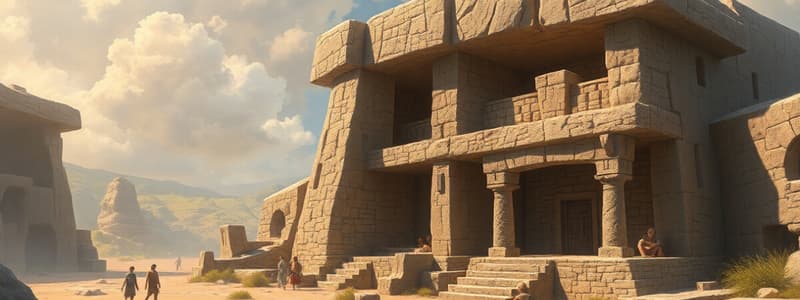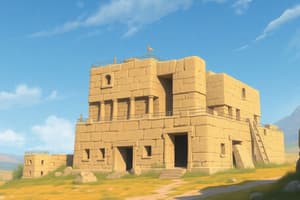Podcast
Questions and Answers
Which of the following is a purpose of primitive architecture?
Which of the following is a purpose of primitive architecture?
- Transportation
- Military defense
- Artistic expression
- Providing shelter (correct)
What defines a Dolmen or Cromlech in megalithic structures?
What defines a Dolmen or Cromlech in megalithic structures?
- Two or more upright stones supporting a capstone (correct)
- A single upright stone
- A circular arrangement of stones
- A linear arrangement of stones
During which cultural stage did humans start practicing agriculture and building huts from stones?
During which cultural stage did humans start practicing agriculture and building huts from stones?
- Paleolithic
- Bronze Age
- Mesolithic
- Neolithic (correct)
What is the main characteristic of Stone Circles?
What is the main characteristic of Stone Circles?
Which tool was commonly fashioned during the Mesolithic period?
Which tool was commonly fashioned during the Mesolithic period?
What was a significant development in the Bronze Age?
What was a significant development in the Bronze Age?
What purpose did burial rituals serve during prehistoric times?
What purpose did burial rituals serve during prehistoric times?
What distinguishes a Stone Row from other megalithic structures?
What distinguishes a Stone Row from other megalithic structures?
What materials were commonly used for houses during the Iron Age?
What materials were commonly used for houses during the Iron Age?
Which of the following is a characteristic of the monolith or menhir?
Which of the following is a characteristic of the monolith or menhir?
Which Neolithic settlement is known as the oldest city on earth?
Which Neolithic settlement is known as the oldest city on earth?
What feature distinguished the houses in the Catalhoyuk settlement?
What feature distinguished the houses in the Catalhoyuk settlement?
Which of the following burial structures is described as an earthen mound?
Which of the following burial structures is described as an earthen mound?
What significant purpose did the Stone Tower of Jericho serve?
What significant purpose did the Stone Tower of Jericho serve?
What innovation did residents of Skara Brae utilize for winter insulation?
What innovation did residents of Skara Brae utilize for winter insulation?
Which type of stone structure is described as a large stone forming part of a group?
Which type of stone structure is described as a large stone forming part of a group?
What type of structures were primarily found in the Choirokoitia Neolithic Settlement?
What type of structures were primarily found in the Choirokoitia Neolithic Settlement?
Which UNESCO World Heritage Site is believed to be the oldest place of worship?
Which UNESCO World Heritage Site is believed to be the oldest place of worship?
What characterizes the Prehistoric Pile Settlements around the Alps?
What characterizes the Prehistoric Pile Settlements around the Alps?
Which site is recognized as a burial and ceremonial site dating from 2750-1500 BCE?
Which site is recognized as a burial and ceremonial site dating from 2750-1500 BCE?
What is the purpose of the Calanais Standing Stones in Scotland?
What is the purpose of the Calanais Standing Stones in Scotland?
Which structure is identified as a megalithic burial dolmen?
Which structure is identified as a megalithic burial dolmen?
Which prehistoric site features more than 3,000 standing granite stones?
Which prehistoric site features more than 3,000 standing granite stones?
What type of structure is referred to as a Rock Shelter?
What type of structure is referred to as a Rock Shelter?
What distinguishes the Dilmun Burial Mounds in Bahrain?
What distinguishes the Dilmun Burial Mounds in Bahrain?
Which statement accurately describes the Knowth Mounds in Ireland?
Which statement accurately describes the Knowth Mounds in Ireland?
What is a characteristic feature of cliff dwellings?
What is a characteristic feature of cliff dwellings?
What accurately describes a hut based on the provided content?
What accurately describes a hut based on the provided content?
What defines a tent as a type of shelter?
What defines a tent as a type of shelter?
Flashcards are hidden until you start studying
Study Notes
Prehistoric Architecture
- A history of architecture is a record of human efforts to build beautifully, tracing the origin, growth, and decline of styles across centuries and cultures.
- Architecture is concerned with sheltering humans and providing structures for their various needs such as worship, amusement, business, tombs, and more.
- The origins of architecture are in prehistoric times, stemming from humans’ basic needs for:
- Protection from the elements and wild animals
- Comfort for sleeping and rest
- Food storage
- Perpetuation of human life.
The Evolution of Man
- The evolution of man is divided into three cultural stages:
- Stone Age:
- Paleolithic: used stones and bones as tools, were nomadic, lived in caves and rock shelters.
- Mesolithic: fashioned stone tools like bows, made canoes, and built huts from bone, animal hides, reeds, and grass.
- Neolithic: polished stone tools for grinding, cutting, and chopping; developed agriculture and domesticated animals; built huts from stones and mud, and practiced burial rituals with tombs.
- Bronze Age: metalworking with bronze was developed, houses were built from wood and stone with conical thatched roofs, the cuneiform and hieroglyphic writing systems were developed.
- Iron Age: weapons were made of iron and steel, houses were built with mud, stone, and wood with thatched roofs, communities lived in hill forts with religious beliefs, traditions, and cultures.
- Stone Age:
Prehistoric Religious and Funerary Structures
- Megaliths: large stones, sometimes forming part of a group, used in diverse ways, such as tomb landmarks, astronomical observatories, or memorials.
- Dolmen/Cromlech: two or more upright stones supporting a slab or capstone, served as tomb landmarks.
- Stone Circle: upright stones in a circular arrangement, used for burials and social rituals.
- Stone Row: upright stones in a linear arrangement, possibly marking a processional route and usually associated with stone circles.
- Stone Alignment: upright stones aligned in many rows, thought to be religious or scientific in meaning.
- Monolith or Menhir: single, great upright stone with varying functions like astronomical observatories, landmarks, or memorials.
- Barrow/Tumulus: an earthen mound burial.
Prehistoric Settlements
- Stone Tower of Jericho, Palestine (8500-7000 B.C.E.): the oldest skyscraper, part of the earliest Neolithic settlement of Jericho, the oldest city on Earth. The Tower was linked to the summer solstice and may have been a symbolic shield against darkness.
- Catalhoyuk, Turkiye (7500 BC-5700 BC): a Neolithic settlement with rectangular, single-roomed huts with mud-plastered walls and floors. Houses touched each other, lacked doors, and were entered through holes in the rooftops. Having rooftops entrances were likely safer than having them on the walls.
- Skara Brae Neolithic Village, Scotland (3180 BC - 2500 BC): an UNESCO World Heritage Site (1999); residents used earth sheltering as insulation from winter.
- Choirokoitia Neolithic Settlement, Cyprus (7th-4th millennium BC): an UNESCO World Heritage Site (1998); the settlement had mud bricks and stone huts clustered around a courtyard where domestic activities took place. The dead were buried beneath these houses.
- Prehistoric Pile Settlements around the Alps (5000 to 500 B.C.): an UNESCO World Heritage Site (2011), these water settlements were raised above water by stilts.
Prehistoric Dwellings
- Rock Shelter: a shallow, cave-like opening at the base of a bluff or cliff.
- Cave: a cavern or a natural void in the ground.
- Hut: a temporary shelter of simple construction built from tree barks and branches, animal hides, plant materials (thatch, straw), stones, bones, mud, or ice.
- Tent: a shelter consisting of sheets of animal hides or other material draped over or attached to a frame of poles or attached to a supporting rope. Used as shelter for nomadic tribes and temporary shelters during seasonal movements.
Examples of Religious and Funerary Structures
- Lanyon Quoit, England: a megalithic burial dolmen.
- Stonehenge, England (2750-1500 BCE): a UNESCO World Heritage Site (1986) and one of the most famous sites in the world, used as a burial and ceremonial site.
- Gobeklitepe, Turkey (9,600 - 8,200 BCE): believed to be the oldest place of worship/sanctuary, predating Stonehenge by 7,000 years, and a UNESCO World Heritage Site (2018).
- Mnajdra Temple, Malta (3500 – 2500 BC): a Neolithic megalith temple, ceremonial and astronomical observatory, and a UNESCO World Heritage Site (1992).
- Merrivale Stone Row, England (2500-1000 BC): a prehistoric Bronze Age ritual site.
- Rudston Monolith, Yorkshire, England: a 25’ stone likely marking a prehistoric holy place or worship center.
- Stenness Stones, Orkney, Scotland: a UNESCO World Heritage Site (1999).
- Calanais Standing Stones, Scotland (2900 and 2600 BC): a Neolithic ritual site believed to be 5,000 years old, predating Stonehenge by 2,000 years. May have been an astronomical observatory or a celestial calendar.
- Carnac Stone Alignment, France (3,300 BC): a Neolithic site with more than 3,000 prehistoric standing granite stones, forming the largest such collection in the world.
- Dilmun Burial Mounds, Bahrain (2200 -1750 BCE): the largest prehistoric burial mounds in the world, a UNESCO World Heritage Site (2019).
- Knowth Mounds, Ireland: a Neolithic burial consisting of 1 big mound and 17 smaller mounds, a UNESCO World Heritage Site (1993).
Studying That Suits You
Use AI to generate personalized quizzes and flashcards to suit your learning preferences.




